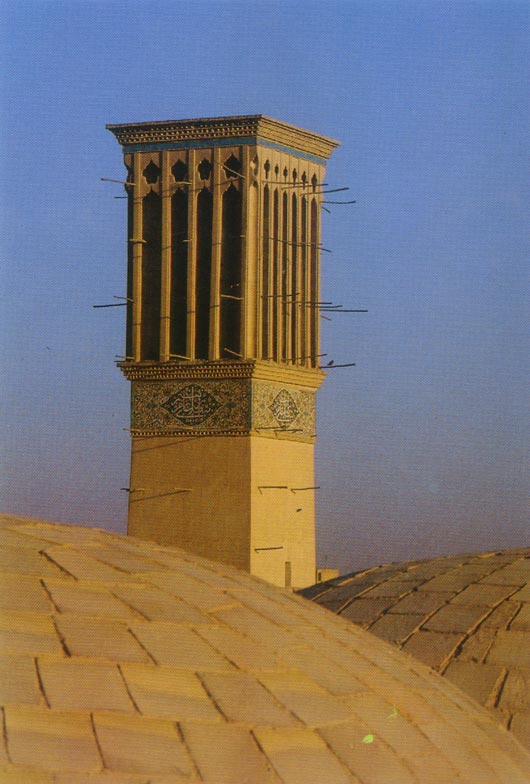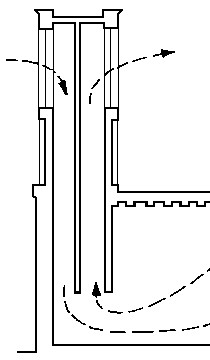Architectural Fluid Dynamics

 Iranian wind towers
Iranian wind towers
Wind towers are designed to
introduce cool outside air, driven by positive wind pressure. The internal
partition allows the low pressure on the lee side of the tower to suck air from
inside the building
· Personnel
Diogo Bolster
Morris Flynn
Qing (Anna) Liu
Jong Keun Yu
Architectural fluid dynamics concerns the flow in and around
buildings. This flow is responsible for the ventilation of buildings and the
quality of the indoor air. The linkage of the interior flow with the complex
flow outside is achieved either through natural ventilation or by introducing
the air mechanically. Once inside the building it is delivered to the various
spaces again either mechanically or as a result of flows through openings
between spaces. The flows, both internal and external,
generally turbulent and often strongly affected by buoyancy forces caused by
temperature differences.
Architectural fluid dynamics concerns the dynamics of these
flows and, as such, is a cross between classical engineering fluid dynamics and
geophysical fluid dynamics. Most engineering flows, such as in an internal
combustion engine, or around a vehicle are dominated
by the geometry. They need to be calculated for the specific boundary
conditions that the geometry imposes. Geophysical fluid dynamics, on the other
hand, is a study of flows for which boundaries usually only play a minor role.
The flows are governed by internal dynamics associated with buoyancy and Coriolis forces. In both cases methods have been developed
for making these calculations. For engineering flows by including the geometry
explicitly and for GFD by simplifying the geometry and considering, for
example, periodic domains.
In AFD the flows are determined both by the geometry and by
the internal dynamics in about equal measure. The flow through a building is
determined both by the internal geometry and the location and sizes of openings
and also by pressure and buoyancy forces. This combination makes computation
especially difficult. In addition, it is often desirable to make calculations
of flows in the design phase when the building geometry is evolving – often
quite radically.
The challenge is to develop ways of making calculations of
these flows that are relatively simple and yet robust. Architects and designers
need to be able to evaluate how their buildings will ventilate, how they will
affect (and be affected by) the local external flow, and what the implications
for air quality and energy consumption. They need to make these calculations
for weather variations experienced over a typical year, so many cases often
need to be run. Our research is aimed at developing this methodology and
improving understanding of how buildings operate and perform.
According to the Energy Information Administration, in 1997
over 5% of the total annual energy consumption of the
Therefore, it is vitally important to develop and apply
innovative design strategies and technologies to the built environment to
reduce the amount of energy consumed by the heating and cooling of buildings.
Also, in the light of increased stress on energy supply mechanisms (as recently
evidenced in
Natural ventilation – ventilation driven by the natural
forces of wind and temperature – is a reliable, low-maintenance and
energy-efficient method to keep air quality and temperature inside buildings
within safe and comfortable limits. Motion of air within a building is induced
naturally (i.e. without a mechanical driving mechanism) when air masses of
different density or pressure come into contact. Such density changes arise
from variations in temperature or composition (due for example to varying gas
content).
Over the past few years there has been considerable research
effort aimed at improving understanding of natural ventilation of buildings
(see [121] for a recent review). We have developed analogue laboratory systems,
in which density differences may be represented by several different methods.
Most commonly, saline solutions with different concentrations have been used,
although it is also possible to vary the temperature, and hence density of the
water. By varying the density contrasts and the geometry of the laboratory
systems, dynamic similarity between the laboratory and air flow within a real
building may be achieved. It is then possible to isolate and study in detail
various aspects of the full-scale flow.
Such experimental investigations have two principal
benefits. Firstly, using modern visualization and data acquisition equipment,
high-quality data and flow visualization may be obtained, avoiding many of the
inherent difficulties of data acquisition in full-scale rooms. Visualizations
can shed light on the qualitative aspects of the behaviour of real flows, and
help to identify processes which may not be easy to observe in real buildings
or numerical simulations. Secondly, the high-quality quantitative data obtained
in the laboratory experiments may be used to formulate and test quantitative
models of natural and mixed-mode ventilation using both natural and mechanical
ventilation systems in various circumstances. These simple, experimentally
based models may be used to parameterize and validate numerical simulations of
the flows within buildings.
Underfloor air
distribution (UFAD)
UFAD is a relatively new approach to the delivery of air in
an air conditioned building. Air is supplied to the space through ‘diffusers’
located in the floor, rather than from registers in the ceiling as in
conventional overhead systems. The floor is raised above the slab and supported
on columns to provide a supply plenum. The height of the plenum is typically
0.30 m and it is pressurized to about 0.1 cm water. This pressure drives the
conditioned air through the diffusers into the space above,
The return is usually in the ceiling.